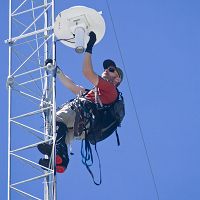Krekez et al., 2009
The Science of Wireless Sensor Networks: Improving engineered systems through scientific analysis.
Krekez, B., Meadows, M., Glaser, S.D., Bales, R.C. (2009)
Fall meeting, American Geophysical Union, December 2009. 90(52). Abstract IN13C-03.
-
Sierra, COLLABORATOR
-
Sierra, STAFF
-
Sierra, INVESTIGATOR
-
Sierra, INVESTIGATOR
Abstract
We assessed the effects of environmental factors on the performance of a wireless sensor network in a remote mountain environment in the Sierra Nevada of California. The deployment of these networks for environmental monitoring applications, although in its relative infancy, is bound to become ubiquitous as a means of large-scale data aggregation and real-time data analysis. The knowledge gained from our study will allow scientists and engineers to design cognitive, self-optimizing, networks, which are capable of interacting with sensed data to respond to changes in the environment by intelligently selecting channel frequencies and data routing algorithms. Our testbed is located in the Southern Sierra Critical Zone Observatory, which is co-located with the Kings River Experimental Watersheds at an elevation of about 2,000m. The site receives a mix of snow and rain during the cold season. Site conditions range from heavily wooded areas to open, marshy meadows. Average spacing between the nodes was 50m, with some spans exceeding 100m. Network statistics show diurnal fluctuation in performance, most probably related to variations in absolute humidity. This is a serious issue for all low-power, high-frequency radio transmission. One way to quantify network link quality is the average packet delivery ratio. In-air water concentrations of 14mmol/mol (measured 50m above ground) corresponded to the dropping of 60% of all packets transmitted, while concentrations of 8mmol/mol saw only 5% of packets requiring retransmission. This corresponds to system latency values - the time delay of messages traveling through the system - ranging from 0.4s to 20s, with an average 5s. The average received signal strength indicator (RSSI) values between nodes measured -58dBm, ranging from -28dBm to -90dBm, where low RSSI corresponded to a larger distance between nodes. Note that a value of -80dBm and below is considered unacceptable, while a deployment in a large indoor space showed average RSSI of -48dBm for similar distances. More seriously, unexpected bottlenecks (one link connecting multiple sub networks) emerged. Treecover and topology in those regions offer no explanation for this behavior. It is believed that these clusters formed due to local environmental conditions, but localized humidity measurements are required for a confident conclusion to be drawn.
Citation
Krekez, B., Meadows, M., Glaser, S.D., Bales, R.C. (2009): The Science of Wireless Sensor Networks: Improving engineered systems through scientific analysis . Fall meeting, American Geophysical Union, December 2009. 90(52). Abstract IN13C-03. .
Explore Further




